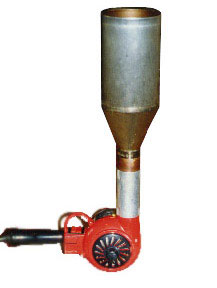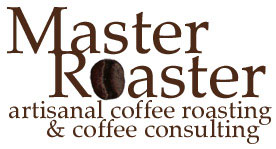|
A large and enjoyable argument has
gone on for some time about the two basic technologies of roasting
equipment: there are drum-style machines that are said to achieve
masterful roasts by browning coffee beans in a maturing atmosphere
of enriched aromas. And, there is hot air technology that suspends
beans in a clean but very hot airflow creating convection conditions
to uniformly roast to peak time and temperature.
The argument is not settled here. But something
else is offered that can enhance the outcome for any roast master
on any equipment, whether drum or hot air. It is the use of a
simple but very effective sample roaster and a sample roasting
system to preview the roast characteristics or a particular bag
of greens, of a sample from a broker, or of a current of past
crop in comparison. Then using this data, a roast master can
set the best roast time and temperature for a beak profile production
roast system.
Here are tools to develop a sample roasting
system that can establish peak production profiles.
Looking at Green Growth and Production
Standards
Green samples can be evaluated in two ways.
One is by the aromatic information that they contain about freshness,
process acceptability, and storage or shipping quality. This
is gathered by nosing, literally, into the small bag or envelope
that the green sample has come in. It becomes very obvious after
very few samples that freshness and defects are easily discernible.
The other observation is made by pouring the sample onto a white
tray or plate. White is an extremely good background for close
observation. You can use a magnifying glass for at least one
pass over the beans. With magnification, defects such as mold
or foreign matter like paint, dye, or oil become clear.
There are very good and useful coffee industry
standards that can be referred to gather comparative information
for the greens that are being examined. Both sets of standards
are in the form of large posters that can be wall-mounted for
a useful display, and cover in different formats the amount of
defects by kind that will devalue a green sample. One set is
available from the Green
Coffee Association of New York, and is a group of three posters.
The other is a Green Coffee Classification System, available
from the Specialty Coffee Association of America, and its Resource
Center. Both sets contain their own explanatory information to
let you judge and grade a particular green sample according to
the standards, and compare your results with the grade that was
attached to the sample by the grower or broker.
Green Density and Size
Another part of the system is a comparative
measure of green bean density. Studies show the direct relationship
between greens with higher density and cup quality. Sivetz,
Coffee Technology 262 (1979). Roast masters probably have
already reached the same conclusion by intuition as they have
felt, smelled, and looked over healthy, fresh crop greens from
high elevations.
To develop an easy assessment of relative
density, you can use the same cups you have on hand for cupping
roasted samples and a good scale that will measure in grams.
Pick one of the cups as your standard container. Fill it with
the green sample, shake it well to eliminate extra space and
fill and shake it again if necessary to bring the bean level
to the top of the cup. Then weigh the sample in grams. You can
choose a comparative sample from one of your known good quality
beans or one of the growths that are generally found to be the
most dense: Sumatra and Sulewasi. Coffee Technology 262.
Measure, shake, and weigh in the same manner. This will give
you a comparative base.
Screen size might provide some information
about the character of the green sample you are looking at, if
you thought the sample was of a different size than it is represented
to be and you had invested in a set of screens and a rotap that
mechanically agitates the screens properly. But far more important
than the relative screen size is cup quality, and that is represented
by overall quality of the beans, which most importantly means
uniformity in size, color, freedom from defects, and fresh odor,
so for our purposes, screen size is only of relative importance.
Given high quality beans, cup quality can be sorted out by profile
sample roasting rather than relative screen size.
 Simple Sample Roasting Simple Sample Roasting
What is chosen here for sample roasting,
a small commercial heat gun, available from any hardware catalog,
is very effective for sampling, and, even though it relies on
hot air roasting, it does a remarkable job. The information gleaned
from this sample roaster can be transferred readily to the production
roast profiles of either drum or air roasters. The heat gun sample
roaster is also far less expensive. It is portable and uses the
most available power source. You can take it to your broker's,
to customers, or to the very plantation you want to sample if
you luckily can go there yourself.
An off-the-shelf model of this roaster
comes from Sivetz Coffee Company. The version pictured here has
a modified chamber, which you can have built for you by any sheet
metal fabricator, which slides over the nozzle of the gun, replacing
the chamber that came with it. This modification allows the chamber
to be completely open without any sort of screen at the top.
The chamber height is at the level to which any of the roasting
beans are able to rise during roasting, and still short enough
to allow the chaff and debris to travel up and out in the hot
air column.
The sample roaster holds approximately
60 grams of greens. The right amount can be determined easily.
When it is on, you should pour beans slowly into the upturned
mouth of the roaster. The amount is right when the mass or weight
of the beans has nearly overcome the ability of the moving air
column to lift and roll them.
Now you can see the entire bean mass as
it begins roasting. The roast chamber is open and points upward
at you so you can have an immediate picture of the relative uniformity
of the development of the beans, comparing each one with every
other one as the beans tumble past your view. This small roaster
gives you a visual and aromatic picture of the entire mass of
roasting beans throughout the roast. All you have to do is hold
your head over the heat gun's roast chamber. You will experience
a beauty and subtlety of roast development aromas that few people
can. The upward airflow is an intense data stream for evaluation,
as much as and more than is provided by a traditional sample
drum roaster.
Chaff comes off as the beans expand and
soften, before the beans reach the critical stage of pyrolysis,
at 400 degrees F. The amount and uniformity of the chaff flight
are very good indicators of the worth and finish of the processing
that the beans have undergone, the uniformity of the beans themselves,
and, probably, of their relative freshness. Often the freshest,
most flavorful, and aromatic beans display very vibrant light
green and yellow drying colors. This is the time that many storage
and freshness defects are very apparent. And this is when lovely
toasty and earthy aromas are noticed from high quality samples.
If you choose, you can measure temperature
within the roast chamber by using a high temperature portable
lab thermometer. Have a small hole drilled near the bottom of
the expanding neck of the chamber where the bean mass tumbles
as it roasts, and insert the thermocouple when you are roasting.
Such a portable thermometer is available from Edmund
Scientific.
Another tool to have handy is a stopwatch.
You can time three critical points in the entire roast development,
all of which are seen by looking down the throat of the roast
chamber on top of the heat gun. You can establish a picture for
yourself of normal roast development as your experience grows
with various roasts.
- With the sample roaster first pop is noticeable
by the singular popping of each of the beans, very decidedly
loud and mechanical. The aromas now can be fruity, flowery, beefy,
chocolaty, or spicy, or many subtle combinations.
- Second pop also is easily heard after
an intervening quiet space, as heat builds up within the beans.
It produces less determined by more universal pops within a very
short time as the beans approach light roast temperature. You
can make some critical decisions at this point about backing
off the temperature to avoid the heavy end effect of deep blue
smoky roasts, or you can go just the opposite and smoke 'em for
a hefty, carbony finish, oiled and decidedly noir.
- You are also able to time the end of the
roast with the stopwatch to see the relative development time
of each degree of roast. Each of these roast profiles then awaits
your judgment at cupping. Roast time and temperature on the heat
gun can be controlled by opening or closing the vented aperture
at the side of the gun's fan.
Peak Profiles Easily
To get peak profiles for each green sample,
you can select the roast you want to try for the sample, say
very light, medium, and medium dark, a set that suggests that
the bean sample would be best represented by lighter roasts.
Then you can roast away, cool, and cup, selecting or rejecting
the results and finally establishing the peak production roast
profile you have uncovered.
Roast profiles that are at the peak for
a particular sample can further be identified by using a roast
color analysis system, such as the one by Agron, available in
the least expensive forma s a set of roast color tiles, which
are related to roast degree designations that can be used as
reference points in production roasting. This set is available
from the Specialty Coffee Association's
Resource Center.
Using the sample roaster/heat gun and the
other tools for green sample analysis, you can roast samples
under broad profiles and use all the information about the green
samples to set the peak profiles which genuinely characterize
your personal roast style as a master roaster. And as you enjoy
sample roasting for peak profiles and cupping from the array
of samples before you, you can say: "What superbly wonderful
work it is to be a roast master!"
© 1999 by John Gant
|

